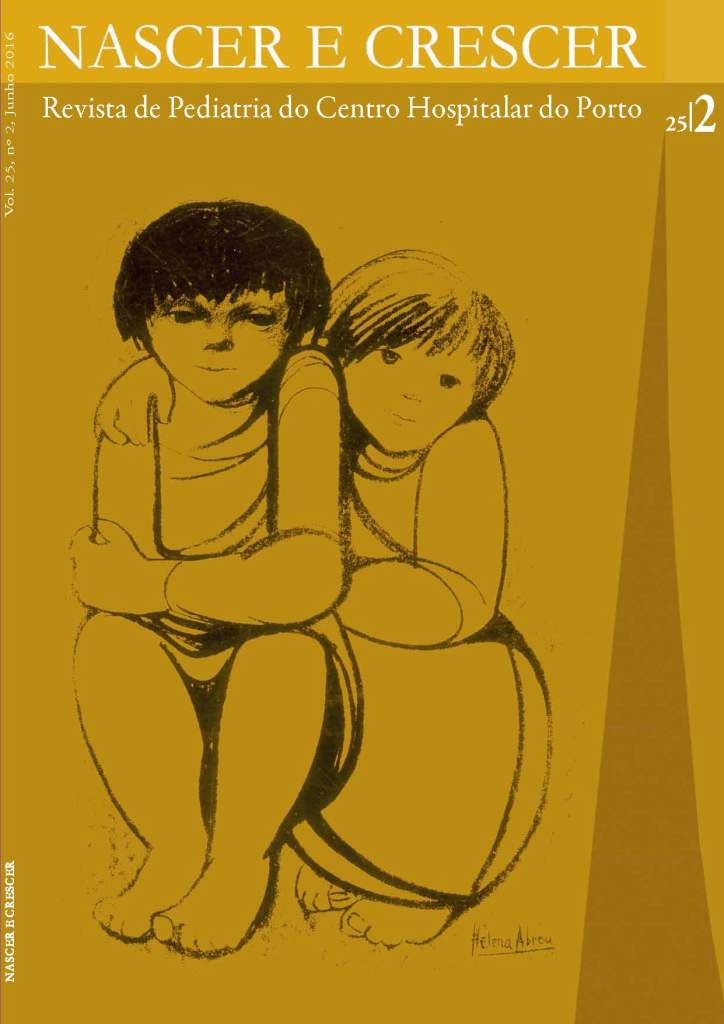RENOVASCULAR HYPERTENSION IN A 12 MONTH OLD BOY: WHAT CAN THE RADIOLOGIST DO?
DOI:
https://doi.org/10.25753/BirthGrowthMJ.v25.i2.9521Keywords:
Hypertension, renovascular, Percutaneous transluminal angioplasty, ultrasonography, DopplerAbstract
We report a clinical case of renovascular disease, probably linked to fibromuscular dysplasia, in a 12 months old boy with severe arterial hypertension with target-organ damage, highlighting the radiological approach.
Initial investigation included renal ultrasound that showed normal sized kidneys, with normal cortical echogenicity on the right and focally increased echogenicity of the posterior aspect of the left kidney, forming a mass-like lesion. Magnetic resonance imaging excluded renal tumor, which was confirmed by ultrasound guided biopsy. A doppler ultrasonography was also performed suggesting a right renal artery stenosis and decreased flow to the posterior aspect of the left kidney. Angiography with diagnostic and therapeutic intention was performed: right renal artery stenosis was detected and transluminal ballon dilation was performed; the left renal artery bifurcated precociously and the branch that irrigated the posterior part of the kidney had a stenosis which was also successfully dilated. After the intervention good blood pressure control with antihypertensive drugs was achieved, which was not possible before the angiographic procedure.
The authors underline various methods of imaging used to accurately diagnose renovascular disease and the usefulness of interventional radiology treatment for this disease in very young children.
Downloads
References
Srinivasan A, Krishnamurthy G, Fontalvo-Herazo L, Nijs E,Keller MS, Meyers K, Kaplan B et al. Angioplasty for renalartery stenosis in pediatric patients: an 11-year retrospectiveexperience. J Vasc Interv Radiol. 2010;21: 1672-80.
Giavroglou C, Tsifountoudis I, Boutzetis T, Kiskinis D. Failureand success of percutaneous angioplasty in a hypertensivechild with bilateral renal artery stenosis. C CardiovascIntervent Radiol. 2009;32: 150-4.
Marks SD, Tullus K.. Update on imaging for suspectedrenovascular hypertension in children and adolescents. CurrHypertens Rep. 2012;14: 591-5.
Tullus K, Roebuck DJ, McLaren CA, Marks SD. Imaging inthe evaluation of renovascular disease. Pediatr Nephrol.2010;25: 1049-56.
Slovut DP, Olin JW. Fibromuscular dysplasia. N Engl J Med.2004; 350: 1862–71.
Burnei G, Burnei A, Hodorogea D, Gavriliu S, Georgescu I,Vlad C et al. Reno-ureteral diseases inducing hypertensionin children. Rom J Intern Med. 2008;46: 367-74.
Chhadia S, Cohn RA, Vural G, Donaldson JS. Renal Dopplerevaluation in the child with hypertension: a reasonablescreening discriminator? Pediatr Radiol. 2013;43: 1549-56.
Zhu G, He F, Gu Y, Yu H, Chen B, Hu Z et al. Angioplasty forpediatric renovascular hypertension: a 13-year experience.Diagn Interv Radiol. 2014;20: 285-92.
Alfonzo JP, Ugarte C, Banasco J, Fraxedas R, GutiérrezF, Lahera J. Renovascular hypertension in children andadolescents: diagnosis and treatment over 19 years.Nefrologia. 2006;26: 573-80.
Dworkin LD, Cooper CJ. Clinical practice. Renal-arterystenosis. N Engl J Med. 2009:12;361: 1972-8.
Alhadad A, Mattiasson I, Ivancev K, Gottsäter A, LindbladB.Revascularisation of renal artery stenosis caused byfibromuscular dysplasia: effects on blood pressure during7-year follow-up are influenced by duration of hypertensionand branch artery stenosis. J Hum Hypertens. 2005;19: 761-7.
Kari JA, Roebuck DJ, McLaren CA, Davis M, Dillon MJ,Hamilton G et al. Angioplasty for renovascular hypertensionin 78 children. Arch Dis Child. 2015;100: 474-8.
Niimura F, Matsuda S, Okamoto S, Suganuma E, Takakura H, Sugiyama Y et al. Renovascular hypertension due to bilateralrenal artery stenosis treated with stent implantation in a 12-year old girl. Tokai J Exp Clin Med. 2008:20;33: 78-83.
Geavlete O, Călin C, Croitoru M, Lupescu I, Ginghină C.Fibromuscular dysplasia-a rare cause of renovascularhypertension. Case study and overview of the literature data.J Med Life. 2012:15;5: 316-20.
Downloads
Published
How to Cite
Issue
Section
License
Copyright and Authors' Rights
All articles published in Nascer e Crescer - Birth and Growth Medical Journal are Open Access and comply with the requirements of funding agencies or academic institutions. For use by third parties, Nascer e Crescer - Birth and Growth Medical Journal adheres to the terms of the Creative Commons License "Attribution - Non-Commercial Use (CC-BY-NC)".
It is the author's responsibility to obtain permission to reproduce figures, tables, etc. from other publications.
Authors must submit a Conflict of Interest statement and an Authorship Form with the submission of the article. An e-mail will be sent to the corresponding author confirming receipt of the manuscript.
Authors are permitted to make their articles available in repositories at their home institutions, provided that they always indicate where the articles were published and adhere to the terms of the Creative Commons license.


